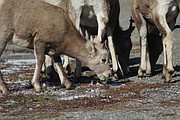Officials urge drivers to watch out for bighorn sheep
The bighorn sheep is an animal that is held in high regard in Sanders County — after all it is featured on the county seal.
Known for their impressive horns and athletic stature, the native sheep are cause for great concern in the county during the winter.
While sheep spend a lot of time at higher elevations, they are spending more time in the valley as the weather becomes more difficult.
This means the sheep have more potential for being involved in collisions with vehicles, particularly on Montana 200.
As the roads ice and are salted many of the sheep will come onto the roads to eat the minerals as well as to escape the even colder mountain tops.
There are four herds monitored by Montana Fish, Wildlife and Parks in Sanders county but the herd most in danger of being wiped out by vehicles is the Thompson Falls band that calls this stretch of highway home.
In the 1940s, the bighorn sheep of the valley were all but wiped out, so Game and Fish reintroduced a few animals in the 1950ss.
In 2006 the herd was measured at around 250. The population then, for some unknown reason, dropped steeply. In 2008 the herd’s population was observed as low as 30. Those numbers rose again steadily to around 75 to 85 members that are recognized today but have been taking more major losses from vehicular incidents within the last few years.
Officials say about 12 sheep die in vehicle crashes a year.
The Montana Department of Transportation and Game and Fish put together a project to hopefully mitigate the likelihood of sheep-vehicle collisions. A section of fence and a wildlife crossing bridge were installed just a few miles east of Thompson Falls on Montana 200, between mile markers 64 to 65. They did construction on about a mile of road and plan on doing the same for another section or road known as the Bad Rock area.
Wildlife deterrent mats were also installed, which deliver a mild, but harmless electric shock.
This was done after several attempts to mitigate the problem such as slowing the speed limit, putting up signs, and more. Fish and Game officials hope that this will solve the problem because about 85% of sheep collisions occurred in that area.
A 2.7-mile section of highway was also widened in the area.
Officials urge drivers to keep a lookout for these animals along the roads and to slow around steep curves, especially around the numerous rock outcroppings that line much of Montana 200, and other roadways in and near the county.



